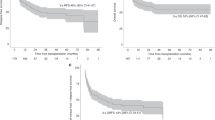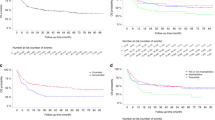Summary:
Stem cell transplantation (SCT) may be the only curative option for patients with relapsed or refractory leukaemia, that is, high-risk (HR) leukaemia. Several salvage regimens have been used to cytoreduce disease before SCT, but disease progression or treatment toxicity limits numbers of patients receiving SCT. Here, we report our experience with high-dose cytarabine and amsacrine (Ara-amsa) to salvage patients with HR-leukaemia in the context of SCT. A total of 34 patients with HR-leukaemia (20 AML, 12 ALL, two advanced CML) received 3 g/m2/day cytarabine for 5 days and amsacrine 200 mg/m2/day for 3 days. Disease response was observed in 62% of patients. Toxicity was limited to neutropenic fever, one patient developed cerebellar toxicity and there was one treatment-related death. A total of 17 patients proceeded to SCT (12 allografts and five autografts). Median survival (OS) of all patients was 10.8 months (95% CI 7.8–21). Patients who were consolidated with SCT after salvage therapy had a superior median OS of 29.4 months (95% CI 12.5–upper limit not reached, n=17) than those who did not receive SCT (6.7 months, CI 1.5–8.6, P<0.0001). Median disease-free survival with SCT (23 months) was higher than after treatment with salvage chemotherapy alone (6.7 months, P=0.0002). Thus Ara-amsa can be used effectively to salvage HR-leukaemia, enabling further consolidation with SCT.
This is a preview of subscription content, access via your institution
Access options
Subscribe to this journal
Receive 12 print issues and online access
$259.00 per year
only $21.58 per issue
Buy this article
- Purchase on Springer Link
- Instant access to full article PDF
Prices may be subject to local taxes which are calculated during checkout


Similar content being viewed by others
References
Hann IM, Stevens RF, Goldstone AH et al. Randomized comparison of DAT versus ADE as induction chemotherapy in children and younger adults with acute myeloid leukemia. Results of the Medical Research Council's 10th AML trial (MRC AML10). Adult and Childhood Leukaemia Working Parties of the Medical Research Council. Blood 1997; 89: 2311–2318.
Copelan EA, McGuire EA . The biology and treatment of acute lymphoblastic leukemia in adults. Blood 1995; 85: 1151–1168.
Kantarjian H, Talpaz M, Kontayiannis D et al. Treatment of chronic myelogenous leukemia in accelerated and blastic phase with daunorubicin, high-dose cytarabin, and granulocyte–macrophage colony-stimulating factor. J Clin Oncol 1992; 10: 398–405.
Ruutu T, Hanninen A, Jarventie G et al. Intensive chemotherapy of poor prognosis myelodysplastic syndromes (MDS) and acute myeloid leukemia following MDS with idarubicin and cytarabine. Leuk Res 1997; 21: 133–138.
Grimwade D, Walker H, Harrison G et al. The importance of diagnostic cytogenetics on outcome in AML: analysis of 1,612 patients entered into the MRC AML 10 trial. The Medical Research Council Adult and Children's Leukaemia Working Parties. Blood 1998; 92: 2322–2333.
Secker-Walker LM, Prentice HG, Durrant J et al. Cytogenetics adds independent prognostic information in adults with acute lymphoblastic leukemia on MRC trial UKALL XA. Br J Haematol 1997; 96: 601–610.
Arlin ZA, Feldman E, Kempin S et al. Amsacrine with high-dose cytarabine is highly effective therapy for refractory and relapsed acute lymphoblastic leukemia in adults. Blood 1988; 72: 433–435.
Giona F, Testi AM, Amadori S et al. Idarubicin and high-dose cytarabine in the treatment of refractory and relapsed acute lymphoblastic leukemia. Ann Oncol 1990; 1: 51–55.
Bassan R, Lerede T, Buelli M et al. A new combination of carboplatin, high-dose cytarabine and cross-over mitoxantrone or idarubicin for refractory and relapsed acute myeloid leukemia. Haematologica 1998; 83: 422–427.
Leopold LH, Willemze R . The treatment of acute myeloid leukemia in first relapse: a comprehensive review of literature. Leuk Lymphoma 2002; 43: 1715–1727.
Edenfield WJ, Gore SD . Stage-specific application of allogeneic and autologous marrow transplantation in the management of acute myeloid leukemia. Semin Oncol 1999; 26: 21–34.
Sierra J, Storer B, Hansen GA, John A et al. Transplantation of marrow cells from unrelated donors for treatment of high-risk acute leukemia: the effect of leukemic burden, donor HLA-matching, and marrow cell dose. Blood 1997; 89: 4226–4235.
Uckun FM, Kersey JH, Haake R et al. Pretransplantation burden of leukemic progenitor cells as a predictor of relapse after bone marrow transplantation for acute lymphoblastic leukemia. N Engl J Med 1993; 329: 1296.
IBMTR/ABMTR Newsletter Vol. 9, Issue 1, Feb. 2002.
Martiat P, Ghilain JM, Ferrant A et al. High-dose cytosine arabinoside and amsacrine or mitoxantrone in relapsed and refractory acute myeloid leukaemia: a prospective randomized study. Eur J Haematol 1990; 45: 164–167.
Martino R, Guardia R, Altes A et al. Time sequential chemotherapy for primary refractory or relapsed adult acute myeloid leukemia: results of the phase II Gemia protocol. Haematologica 1999; 84: 226–230.
Archimbaud E, Thomas X, Leblond V et al. Timed sequential chemotherapy for previously treated patients with acute myeloid leukemia: long-term follow-up of the etoposide, mitoxantrone, and cytarabine-86 trial. J Clin Oncol 1995; 13: 11–18.
Jackson G, Taylor P, Smith GM et al. A multicentre, open, non-comparative phase II study of a combination of fludarabine phosphate, cytarabine and granulocyte colony-stimulating factor in relapsed and refractory acute myeloid leukaemia and de novo refractory anaemia with excess of blasts in transformation. Br J Haematol 2001; 112: 127–137.
Freund M, Diedrich H, Ganser A et al. Treatment of relapsed or refractory adult acute lymphocytic leukemia. Cancer 1992; 69: 709–716.
Martino R, Bellido M, Brunet S et al. Intensive salvage chemotherapy for primary refractory or first relapsed adult acute lymphoblastic leukaemia: results of a prospective trial. Haematologica 1999; 84: 505–510.
Martino R, Bellido M, Brunet S et al. Allogeneic or autologous stem cell transplantation following salvage chemotherapy for adults with refractory or relapsed acute lymphoblastic leukaemia. Bone Marrow Transplant 1998; 21: 1023–1027.
De La Serna J, Francisco TJ, Solano C et al. Idarubicin and intermediate dose ARA-C followed by consolidation chemotherapy or bone marrow transplantation in relapsed or refractory acute myeloid leukaemia. Leuk Lymphoma 1997; 25: 365–372.
Byrne JL, Dasgupta E, Pallis M et al. Early allogeneic transplantation for refractory or relapsed acute leukaemia following remission induction with FLAG. Leukemia 1999; 13: 786–791.
Vignetti M, Orsini E, Petti MC et al. Probability of long-term disease-free survival for acute myeloid leukemia patients after first relapse: a single-centre experience. Ann Oncol 1996; 7: 933–938.
de Witte T, Suciu S, Verhoef G et al. Intensive chemotherapy followed by allogeneic or autologous stem cell transplantation for patients with myelodysplastic syndromes (MDSs) and acute myeloid leukemia following MDS. Blood 2001; 98: 2326–2331.
Author information
Authors and Affiliations
Rights and permissions
About this article
Cite this article
Tauro, S., Shankaranarayana, P., Nitu-Whalley, I. et al. Stem cell transplantation after salvage therapy with high-dose cytarabine and amsacrine in adults with high-risk leukaemia. Bone Marrow Transplant 32, 273–278 (2003). https://doi.org/10.1038/sj.bmt.1704113
Received:
Accepted:
Published:
Issue Date:
DOI: https://doi.org/10.1038/sj.bmt.1704113



